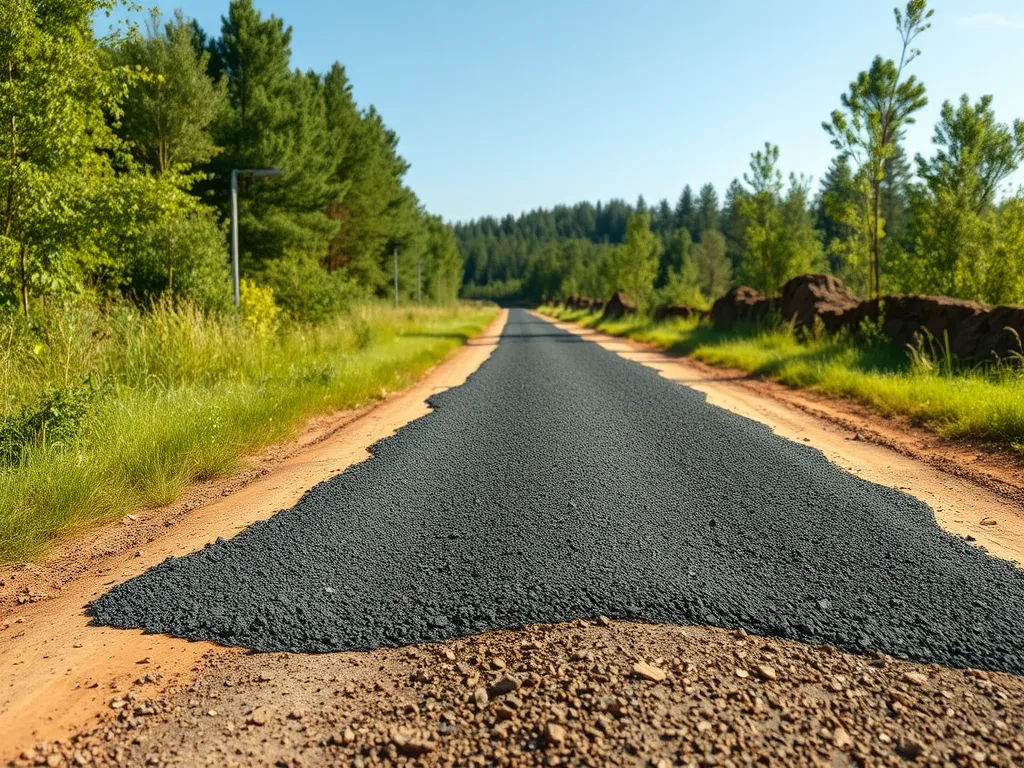Cold Mix Asphalt: The Affordable Fix for Unpaved Road Repairs
Published on: October 13, 2025 | Last Updated: April 14, 2025
Written By: George Voss
Cold mix asphalt is a ready-to-use paving material for maintaining gravel roads, dirt paths, and rural routes without needing heat. Made with aggregates coated in bitumen emulsion or cutback asphalt, this blend stays workable at ambient temperatures. Unlike hot mix asphalt requiring 300°F heating or concrete needing curing time, cold mix can be applied straight from the bag. It’s ideal for filling potholes, smoothing washboards, and stabilizing surfaces on low-traffic roads. Costs range from $35-$75 per ton, with shelf-stable bags available at most construction supply stores.
This guide explains why cold mix outperforms gravel for unpaved road maintenance. You’ll learn how it handles freeze-thaw cycles better than traditional methods, requires only basic tools like shovels and tampers, and reduces long-term costs by 40-60% compared to repeated gravel applications. We break down application steps for different repair types, compare leading brands like EZ Street and UPM, and share pro tips for maximizing durability.
Contents
- Understanding Cold Mix Asphalt
- Benefits Of Cold Mix Asphalt for Unpaved Road Maintenance
- Key Applications Of Cold Mix Asphalt in Unpaved Road Repair
- Step-by-step Application Process
- Pros and Cons Of Cold Mix Asphalt
- Technical Specifications for Optimal Performance
- Purchasing Considerations
- Frequently Asked Questions (FAQ)
- Closing Thoughts
- Additional Resources for You:
Understanding Cold Mix Asphalt
What is Cold Mix Asphalt?
Cold mix asphalt is a ready-to-use road repair material. It combines stone, sand, and bitumen emulsion. Unlike hot mix, it needs no heating before use. This makes it ideal for fixing potholes, cracks, or washouts on unpaved roads. It stays workable in cold or wet weather, even at 40°F. Rural crews use it for fast fixes in remote spots where hot mix plants are out of reach.
How Cold Mix Asphalt Differs From Traditional Asphalt
Hot mix asphalt requires heating to 300°F for proper binding. Cold mix uses emulsified bitumen that bonds at air temp. Hot mix hardens fast but needs heavy gear like pavers and rollers. Cold mix can be applied with hand tools, cures over days, and costs 30-40% less per ton. Hot mix lasts longer under heavy traffic, while cold mix suits low-volume roads needing quick, cheap fixes.
Composition and Production Process
Cold mix asphalt has three main parts:
| Component | Role | Typical % |
|---|---|---|
| Aggregates | Provide strength | 90-95% |
| Bitumen Emulsion | Binds materials | 4-8% |
| Additives (polymers, lime) | Boost water resistance | 1-2% |
Makers coat aggregates with emulsion at room temp. The mix is then bagged or stored in bulk. Some types, like tarmac cold patch, include recycled asphalt chunks. Shelf life ranges from 3-6 months if kept dry.
Now that we’ve broken down cold mix basics, let’s explore how it outperforms other options for gravel and dirt roads.
Benefits Of Cold Mix Asphalt for Unpaved Road Maintenance
Cold mix asphalt offers unique benefits for unpaved roads, which often face limited budgets, harsh weather, and difficult access. Its properties make it ideal for preserving gravel roads, fixing potholes, and preventing erosion without complex setups.
Cost-effectiveness for Rural and Remote Areas
Transporting hot mix asphalt to rural regions costs $150–$200 per ton due to fuel needs for heated trucks. Cold mix eliminates this: it ships at ambient temperatures, cutting fuel use by 40–60%. Pre-packaged bags (50 lb. for $8–$15) let crews fix potholes for under $30 per square foot. No curing equipment or specialized labor reduces project budgets by up to 35% compared to traditional methods.
Quick Application and Minimal Equipment Requirements
Cold patch asphalt requires no heating, mixing, or curing delays. Crews simply clean the repair zone, pour the mix, and compact it with hand tools. Projects finish 70% faster than hot mix installations. Basic tools like shovels, rakes, and vibratory plates (rented for $75–$150 daily) suffice, making it viable for towns with limited machinery.
Durability in Diverse Weather Conditions
Cold mix bonds tightly with gravel bases even at 20°F, resisting freeze-thaw cycles that crack rigid pavements. Modified binders like CSS-1H emulsified bitumen allow flexibility, letting the material shift without crumbling under traffic. Testing shows cold patch repairs survive 2–5 years on unpaved roads with 500–1,500 vehicles daily, outperforming gravel-only fixes by 300%.
Reduced Environmental Impact Compared to Hot Mix
Producing hot mix emits 0.03 tons of CO₂ per ton made. Cold mix cuts this by 55% since it skips heating to 300°F. Recycled asphalt pavement (RAP) constitutes 20–50% of cold mix products, diverting waste from landfills. Unlike hot mix, cold patches need no toxic sealants, reducing groundwater contamination risks by up to 80%.
With these strengths, cold mix asphalt meets the core needs of unpaved road maintenance. Next, let’s explore specific repair techniques that maximize its performance in real-world conditions.

Key Applications Of Cold Mix Asphalt in Unpaved Road Repair
Cold mix asphalt offers versatile solutions for fixing common issues on gravel or dirt roads. Its unique properties make it ideal for rural settings where hot mix plants aren’t accessible. Below are four critical uses that extend the lifespan of unpaved surfaces.
Pothole Repair With Cold Patch Asphalt
Potholes plague unpaved roads after heavy rains or freeze-thaw cycles. Cold patch asphalt bonds with existing materials at ambient temperatures, filling holes without heating. Emulsion-based binders (like CSS-1h or HFMS-2s) allow immediate compaction. A 2-inch layer applied at $25–$40 per ton can stabilize a 10 sq.ft. pothole. For deeper voids, crews layer the mix, compacting each 3-inch section with vibratory rollers.
Surface Leveling and Stabilization
Ruts and washboarding reduce traction on gravel roads. Grading alone won’t fix these issues long-term. Applying a 1.5–2-inch cold mix asphalt layer creates a smooth surface course. The mix penetrates underlying gravel, binding loose aggregates. Projects often pair this with geotextile fabrics, boosting load distribution. Expect 3–5 years of stabilized use before reapplication.
Emergency Repairs for Erosion or Washouts
Flash floods or landslides demand rapid response. Cold mix asphalt sets within 24–48 hours, even under wet conditions. Crews use it to rebuild washed-out shoulders or eroded road edges. A blend with polymer-modified bitumen resists water infiltration, critical for slopes exceeding 6% grade. One county in Montana reported 85% cost savings using cold mix over hot mix for urgent storm repairs.
Preventive Maintenance for Gravel Roads
Annual applications of cold mix asphalt extend gravel road life by 8–10 years. Thin layers (0.75–1 inch) act as a wear surface, reducing dust by 60% and aggregate loss by 45%. The National Center for Asphalt Technology recommends 2–3 tons per 100 linear feet for low-volume roads. This method cuts grading frequency from monthly to quarterly.
Mastering these applications requires knowing how to prepare surfaces and apply materials correctly. Next, let’s break down the step-by-step process to ensure your repairs last.
Also See: Effect Of Weather on Asphalt Pouring Outcomes
Step-by-step Application Process
Applying cold mix asphalt on unpaved roads demands a methodical approach to boost functionality. Following right actions can turn a gravel path into a solid surface lasting up to two years with minimal upkeep.
Preparing the Road Surface for Repair
Start by clearing rocks, dirt, and organic matter from damaged spots. Use a grader or hand tools to flatten ruts or bumps. If fixing potholes, cut vertical walls around voids to create firm edges. For optimal bonding, spray a light coat of bitumen emulsion (SS-1h or CSS-1h) on clean surfaces. Moisture content in soil should stay below 8% to avoid mix weakening.
Selecting the Right Cold Mix Asphalt Type
Pick materials based on traffic load and climate. Aggregate size matters: ½-inch grades suit heavy trucks, while 3/8-inch works for light cars. High-calcium stearate additives improve frost resistance in sub-20°F zones. For quick fixes, bagged cold patch asphalt (like QPR or UPM) bonds without compaction. Stockpile bulk mixes for large projects at $25-$40 per ton.
| Mix Type | Best For | Set Time |
|---|---|---|
| Polymer-Modified | High-traffic roads | 2-4 hours |
| Standard Cold Patch | Temporary fills | Instant |
| Emulsion-Based | Wet conditions | 24-48 hours |
Proper Installation Techniques for Longevity
Pour cold mix asphalt in layers no thicker than 2 inches. For deep holes, compact each layer at 92% density before adding more. Spread material ½ inch above road level to account for settling. Avoid foot traffic for 1-2 hours post-application. In rainy areas, slope patches at 2% grade to divert water.
Compaction and Curing Best Practices
Use vibratory plates for small patches or drum rollers for large zones. Aim for 95% Proctor density to lock out air pockets. Cold mix gains strength slowly—allow 3-7 days for full curing. Traffic can resume immediately but limit heavy loads (>5 tons) during initial curing. Recompact edges after 24 hours to fix shrinkage gaps.
Following these steps lays a strong foundation for road integrity. Up next: how material limits and strengths shape project outcomes.

Pros and Cons Of Cold Mix Asphalt
Cold mix asphalt offers unique benefits for unpaved road maintenance but requires careful consideration of its limitations. Let’s break down its strengths and weaknesses in rural repair scenarios.
Advantages: Flexibility, Accessibility, and Low Maintenance
Cold mix asphalt works in temperatures as low as 20°F, allowing year-round repairs without heating equipment. Crews apply it directly from the bag or stockpile, ideal for remote areas lacking hot-mix plants. Emulsion binders (water-based asphalt mixtures) keep the material pliable, adapting to uneven surfaces like gravel roads or washouts. A single worker with basic tools—a shovel and tamper—can fix potholes in under 30 minutes, reducing labor costs by up to 40% compared to hot-mix methods. Stored properly, unopened bags last 6–12 months, enabling townships to stockpile material for emergencies.
Limitations: Load-bearing Capacity and Long-term Durability
Cold mix asphalt typically supports 1,500–3,000 PSI, less than hot mix’s 4,000+ PSI rating. Heavy truck traffic or frequent agricultural equipment can cause rutting within 6–12 months. Unpaved roads treated with cold patch asphalt may need reapplication every 1–2 years, versus hot mix’s 5–7 year lifespan. Freeze-thaw cycles in northern climates accelerate wear, requiring thicker 3–4 inch layers for stability. While initial costs average $25–$40 per ton (half the price of hot mix), long-term upkeep adds 15–20% to decade-long budgets.
Knowing these trade-offs helps planners balance immediate fixes with future needs. Next, let’s explore technical standards that maximize cold mix performance on unpaved roads.
Technical Specifications for Optimal Performance
Cold mix asphalt repair demands precise specs to last on unpaved roads. Key factors include rock size mixes, binder grades, and test methods for quality checks.
Material Grading and Binder Requirements
Aggregate size shapes performance. Use ASTM D692 or AASHTO M43 gradation rules. Ideal mixes have 3/8-inch to No. 4 sieve stones for tight packing. Binders matter most:
- Emulsified asphalt (slow-setting) for wet climates
- Cutback asphalt (MC-30 or MC-70) for quick dry zones
Binder content ranges 3-5% by weight. Additives like lime (1-2%) boost moisture fight. Polymer-modified binders add flex in freeze-thaw zones.
Quality Standards for Unpaved Road Projects
Follow ASTM D4215 for surface prep. Test mixes with:
- Marshall stability (1,500 lbs min per ASTM D6927)
- Moisture damage checks (AASHTO T283, 80% strength kept)
Compact layers to 95% Proctor density. Check voids stay under 8% to block water. Local rules vary: Caltrans requires 2-inch lifts in erosion zones. TxDOT specs call for 3% lime in high-clay soils.
Meet these bars, and cold patch asphalt holds 2-5 years on gravel roads. Up next: smart buys hinge on right amounts and safe storage.

Purchasing Considerations
Getting the right cold mix asphalt for unpaved road repair starts with smart buying. Focus on how much you need and how to keep it fresh until use.
Estimating Quantity Needs for Repairs
To figure out how much cold patch asphalt you need, measure the repair area. Use this formula: length (feet) x width (feet) x depth (inches) ÷ 12. Multiply the result by 145 lbs per cubic foot. For example, a 2 ft x 5 ft pothole at 3 inches deep needs 2x5x0.25 = 2.5 cubic feet. 2.5 x 145 lbs = 363 lbs (about 7 bags). Buy 10% extra for uneven surfaces. Bulk buys (1+ tons) cut costs to $50-$100 per ton vs $8-$15 per 50 lb bag.
Storage and Shelf-life Of Cold Mix Products
Cold mix asphalt stays workable for 6-12 months if stored right. Keep bags sealed, dry, and under 80°F. Sun or rain can ruin the binder, making chunks hard or sticky. For long-term stock, use pallets off damp ground. If mix dries out, add 1-2% diesel to soften it. Never freeze – thawed mix loses 30% strength.
Proper storage keeps your cold patch pothole filler ready for urgent road fixes. Next, let’s tackle common questions on picking the best mix and making it last.
Frequently Asked Questions (FAQ)
What Are the Disadvantages Of Cold Mix Asphalt?
While cold mix asphalt is beneficial for unpaved roads, its main disadvantages include a lower load-bearing capacity compared to hot mix asphalt and a shorter lifespan. It may also require more frequent reapplications, especially in areas with substantial heavy traffic or challenging weather conditions.
How Long Does Cold Patch Asphalt Last on Unpaved Roads?
Cold patch asphalt generally lasts between 1 to 2 years on unpaved roads. However, this lifespan can vary based on traffic volume and environmental conditions, such as freeze-thaw cycles that may accelerate wear.
Can Cold Mix Asphalt Be Used for Driveway Repairs?
Yes, cold mix asphalt can be successfully used for driveway repairs. It is particularly effective for filling potholes or cracks in low-traffic areas, providing a cost-effective solution for maintaining residential driveways.
What is the Cost Range for Cold Mix Asphalt Projects?
The cost for cold mix asphalt projects typically ranges from $25 to $40 per ton, which can vary based on location, supplier, and specific product type. Bulk purchases often provide cost savings compared to buying smaller bagged quantities.
How to Choose the Best Cold Mix for Pothole Repair?
When selecting the best cold mix for pothole repair, consider the traffic load expected, local climate conditions, and the size of the aggregates. Polymer-modified mixes are ideal for high-traffic areas, while standard cold patches work well for temporary fixes and lighter loads.
Closing Thoughts
Cold mix asphalt proves to be a valuable solution for maintaining unpaved roads. Its unique properties, such as quick application and cost-effectiveness, make it ideal for rural areas and remote locations. The ability to perform repairs efficiently, especially during adverse weather conditions, can significantly extend the lifespan of unpaved surfaces.
While there are some limitations, such as load-bearing capacity, the advantages often outweigh the drawbacks, particularly for short-term applications. By considering the specific technical requirements and best practices for installation, you can optimize maintenance efforts and ensure better road quality.
For more detailed information on cold mix asphalt and its various applications, don’t forget to check out Asphalt Calculator USA.
Additional Resources for You:
- Kett, I. (1999). Asphalt Materials and Mix Design Manual. Oxford: Elsevier Science.
- ARCHIVED: Chapter 12 – 98042 – Recycling – Sustainability – Pavements – Federal Highway Administration
- COLD MIX ASPHALT – McAsphalt


